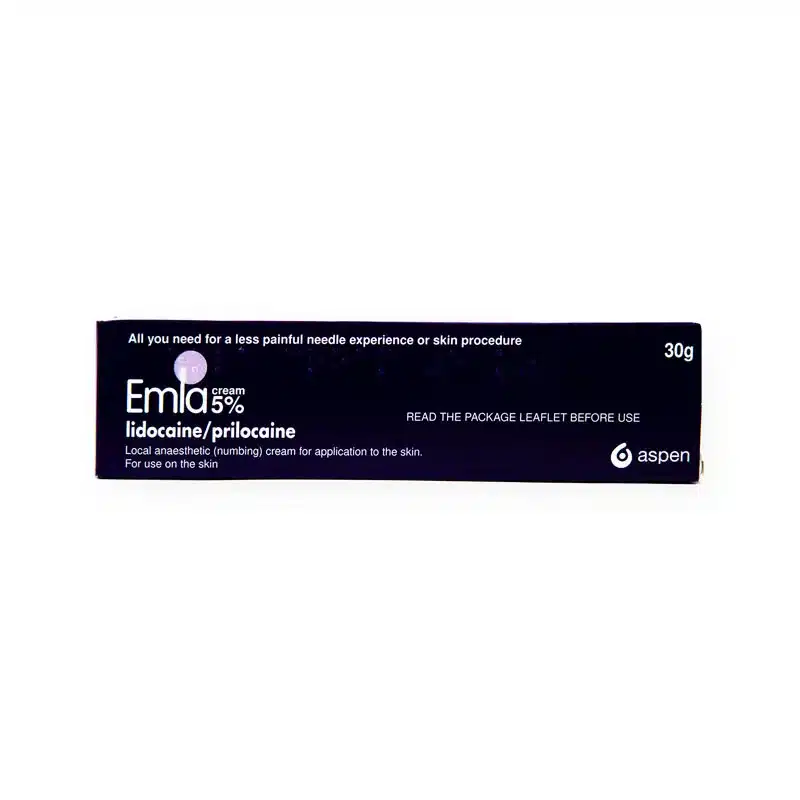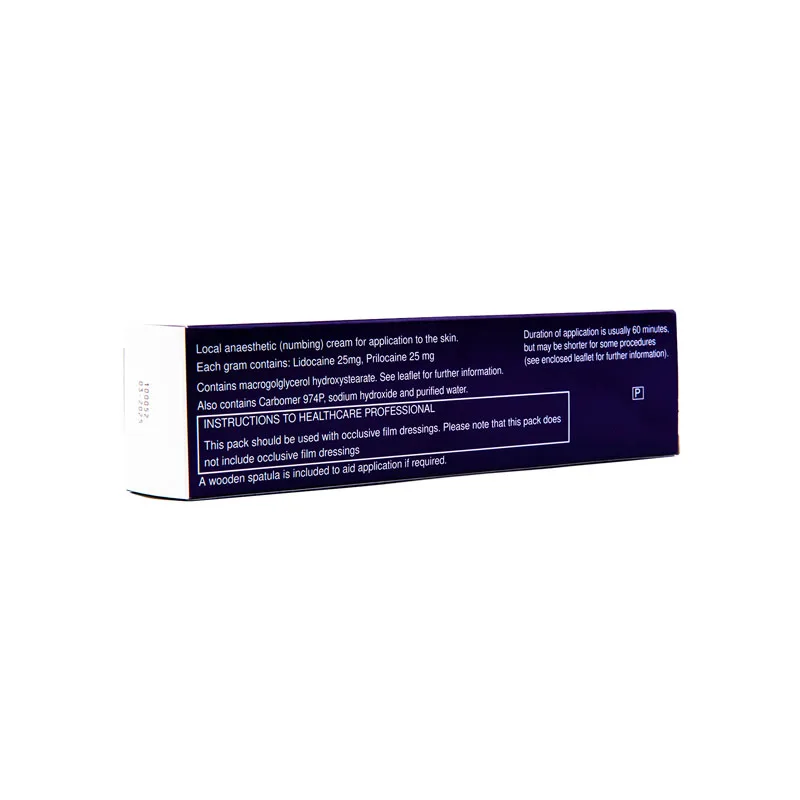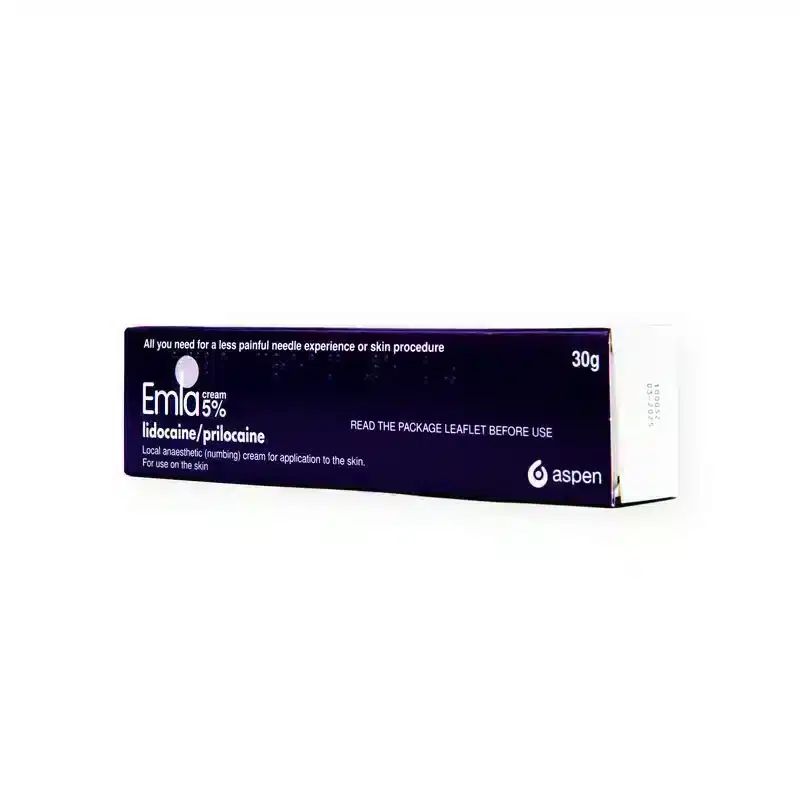

Manufacturer: Astra Zeneca
Active Substance(s): LIDOCAINE, PRILOCAINE
Strength: 25mg/g Lidocaine, 25mg/g Prilocaine
Pack Size: 1 x 30mg Tube
Accessories: Package insert
EMLA™ CREAM contains two medicines called lidocaine and prolicaine. These belong to a group of medicine called local anaesthetics.It is a local anesthetic used to help reduce pain and discomfort from medical procedures such as dermal filler and wrinkle relaxer injections.
INFORMATION
What is Emla cream?
Emla cream is a local anesthetic (numbing medication) that contains 2 forms of localized anesthetic: lidocaine (2.5%) and prilocaine (2.5%). This ointment is indicated for dermal anesthesia in various clinical settings, though it may also be used on genital mucous membranes for superficial, minor surgeries, as well as in pretreatment for infiltration anesthesia.
How do the lidocaine and prilocaine in Emla cream help for medical procedures?
The lidocaine and prilocaine in Emla cream work by blocking nerve signals in the skin, creating a temporary numbing effect. Lidocaine provides rapid pain relief, while prilocaine extends the duration of anesthesia. Together, they ensure effective dermal anesthesia for minor procedures.
What makes a good candidate?
Emla cream is primarily used for pain relief or to numb part of your body. It is suitable for use on patients who are about to undergo any procedures that require dermal pain relief, including electrolysis and laser hair removal. This cream is suitable for use in pediatric patients, including infants, although additional precautionary measures must be taken and the recommended dosage guidelines must be followed closely in these cases. This product is contraindicated in patients with a known hypersensitivity to amide-type local anesthetics or to any other component of the product.
How does Emla patch work?
Emla is a local anesthetic that works by blocking the transmission of pain signals through nerves in the skin. When applied, its active ingredients, lidocaine and prilocaine, penetrate the epidermis and dermal layers, where they gather near pain receptors and nerve endings. Both lidocaine and prilocaine are membrane-stabilizing drugs that prevent action potentials from occurring along the axon membrane in nerve cells, effectively blocking sensations from traveling between peripheral nerves and the central nervous system. Emla provides dermal analgesia through intact skin by inhibiting the influx of sodium through voltage-gated sodium channels, thereby impeding the initiation and conduction of nerve impulses.
How long does Emla last?
Emla will begin to have a numbing effect within 15 minutes of initial application. However, it will take at least 60 minutes for its full analgesic effects of Emla to set in. This loss of sensation will last for 1–2 hours after the cream is removed from the skin. It should be noted that absorption of the medication by the genital mucosa is more rapid. Because of this, the onset time is shorter (at 5 to 10 minutes) than after application to intact skin.
Does Emla cream have side effects?
Yes, Emla cream can have side effects. Common ones include mild burning, itching, or skin color changes at the application site. Rare but serious reactions may involve breathing difficulties, dizziness, irregular heartbeat, or severe skin reactions. A licensed healthcare provider should use it as directed. Patients should immediately consult a doctor if unusual symptoms occur after using Emla.
What is Emla cream?
Emla cream is a local anesthetic (numbing medication) that contains 2 forms of localized anesthetic: lidocaine (2.5%) and prilocaine (2.5%). This ointment is indicated for dermal anesthesia in various clinical settings, though it may also be used on genital mucous membranes for superficial, minor surgeries, as well as in pretreatment for infiltration anesthesia.
How do the lidocaine and prilocaine in Emla cream help for medical procedures?
The lidocaine and prilocaine in Emla cream work by blocking nerve signals in the skin, creating a temporary numbing effect. Lidocaine provides rapid pain relief, while prilocaine extends the duration of anesthesia. Together, they ensure effective dermal anesthesia for minor procedures.
What makes a good candidate?
Emla cream is primarily used for pain relief or to numb part of your body. It is suitable for use on patients who are about to undergo any procedures that require dermal pain relief, including electrolysis and laser hair removal. This cream is suitable for use in pediatric patients, including infants, although additional precautionary measures must be taken and the recommended dosage guidelines must be followed closely in these cases. This product is contraindicated in patients with a known hypersensitivity to amide-type local anesthetics or to any other component of the product.
How does Emla patch work?
Emla is a local anesthetic that works by blocking the transmission of pain signals through nerves in the skin. When applied, its active ingredients, lidocaine and prilocaine, penetrate the epidermis and dermal layers, where they gather near pain receptors and nerve endings. Both lidocaine and prilocaine are membrane-stabilizing drugs that prevent action potentials from occurring along the axon membrane in nerve cells, effectively blocking sensations from traveling between peripheral nerves and the central nervous system. Emla provides dermal analgesia through intact skin by inhibiting the influx of sodium through voltage-gated sodium channels, thereby impeding the initiation and conduction of nerve impulses.
How long does Emla last?
Emla will begin to have a numbing effect within 15 minutes of initial application. However, it will take at least 60 minutes for its full analgesic effects of Emla to set in. This loss of sensation will last for 1–2 hours after the cream is removed from the skin. It should be noted that absorption of the medication by the genital mucosa is more rapid. Because of this, the onset time is shorter (at 5 to 10 minutes) than after application to intact skin.
Does Emla cream have side effects?
Yes, Emla cream can have side effects. Common ones include mild burning, itching, or skin color changes at the application site. Rare but serious reactions may involve breathing difficulties, dizziness, irregular heartbeat, or severe skin reactions. A licensed healthcare provider should use it as directed. Patients should immediately consult a doctor if unusual symptoms occur after using Emla.







